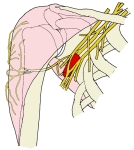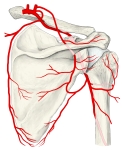三角筋 ( さんかくきん、 英 : deltoid )
・ 概 要 |
・ 作 用 |
・ イラスト掲載サイト |
|
・ イラスト |
・ 神経 / 脈管 |
||
・ 起始 / 停止 |
・ Wikipedia |
![]()


![]()


・ 前部、後部の筋線維は起始から互いに平行して停止に向かっているが、中部では交錯して多羽状を呈している。
⇒ 図解詳解
【 関連語句 】
・ 三角筋大胸筋溝 : 三角筋と大胸筋の間にできる溝で、橈側皮静脈の通路となる。
・ 三角筋大胸筋三角 : deltopectoral triangle 三角筋大胸筋溝の上(鎖骨下部)にできる三角状の窪み
= モーレンハイム三角 ⇒ 図解詳解
以下は 「骨格筋の形と触察法(大峰閣)」 の解説文となる。
「 後部線維の起始付近は、膜様の腱のみで構成されている。・三角筋の起始腱と停止腱は、外面(皮膚側面)ではほとんど観察できないが、内面(骨側面)ではひも状の起始腱と、膜状の停止腱が観察できる。これらの腱は、起始に4本、停止に5本存在する場合が多い。」
![]()
 |
 |
 |
 |
|
 |
 |
 |
 |
![]()
【 起 始 】 : ・ 前部 (鎖骨部) : 鎖骨の外側部1/3
 |
 |
![]()
鎖骨部 : 上腕を屈曲、内旋させる。
肩峰部 : 上腕を外転、外旋させる。
肩甲棘部 : 上腕を伸展、外旋させる。
![]()
・ 神 経 : 腋窩神経 (C5,C6) ※またはC4を含む。
![]()
The deltoid muscle is the muscle forming the rounded contour of the human shoulder. It is also known as the 'common shoulder muscle', particularly in other animals such as the domestic cat. Anatomically, it appears to be made up of three distinct sets of fibers, namely 1. anterior or clavicular part (pars clavicularis) 2. posterior or scapular part (pars scapularis) 3. intermediate or acromial part (pars acromialis). However, electromyography suggests that it consists of at least seven groups that can be independently coordinated by the nervous system.[1]
It was previously called the deltoideus (plural deltoidei) and the name is still used by some anatomists. It is called so because it is in the shape of the Greek capital letter delta (Δ). Deltoid is also further shortened in slang as "delt".
A study of 30 shoulders revealed an average mass of 191.9 grams (6.77 oz) in humans, ranging from 84 grams (3.0 oz) to 366 grams (12.9 oz).[2]
【 語 句 】
・ distinct : 別個の ・ clavicular : 鎖骨の ・ scapular : 肩甲骨の ・ acromial : 肩峰の ・ electromyography : 筋電図検査
【 Structure 】
Previous studies showed that the insertions of the tendons of the deltoid muscle parts formed three discrete sets of muscle fibers, often referred to as "heads":
- The anterior or clavicular fibers arise from most of the anterior border and upper surface of the lateral third of the clavicle. The anterior origin lies adjacent to the lateral fibers of the pectoralis major muscle as do the end tendons of both muscles. These muscle fibers are closely related and only a small chiasmatic space, through which the cephalic vein passes, prevents the two muscles from forming a continuous muscle mass.
- The anterior deltoids are commonly called front delts for short.
- Intermediate or acromial fibers arise from the superior surface of the acromion process of the scapula.
- They are also commonly called lateral deltoid. This muscle is also called middle delts, outer delts, or side delts for short.
- They are also mistakenly called medial deltoid, which is wrong, as their origin is the least medial portion of the deltoid.
- Posterior or spinal fibers arise from the lower lip of the posterior border of the spine of the scapula.
- They are commonly called posterior deltoid or rear deltoid (rear delts for short).
Fick divided these three groups of fibers, often referred to as parts (Latin: pars) or bands, into seven functional components as did Kapandji and Sakoma Y et al. ; the anterior part has two components (I and II); the lateral one (III); and the posterior four (IV, V, VI, and VII) components. In standard anatomical position (with the upper limb hanging alongside the body), the central components (II, III, and IV) lie lateral to the axis of abduction and therefore contribute to abduction from the start of the movement while the other components (I, V, VI, and VII) then act as adductors. During abduction most of these latter components (except VI and VII which always act as adductors) are displaced laterally and progressively start to abduct.
【 語 句 】
・ discrete : 別々の ・ clavicle : 鎖骨 ・ adjacent : 隣接した ・ pectoralis major : 大胸筋 ・ chiasmatic : 交叉の? ・ cephalic vein : 橈側皮静脈 ・ acromion process : 肩峰突起 ・ scapula : 肩甲骨 ・ spine of the scapula : 肩甲棘 ・ axis : 軸 ・ abduction : 外転 ・ contribute : 与える、貢献する
【 Insertion 】
From this extensive origin the fibers converge toward their insertion on the deltoid tuberosity on the middle of the lateral aspect of the shaft of the humerus; the intermediate fibers passing vertically, the anterior obliquely backward and laterally, and the posterior obliquely forward and laterally.
Though traditionally described as a single insertion, the deltoid insertion is divided into two or three discernible areas corresponding to the muscle's three areas of origin. The insertion is an arch-like structure with strong anterior and posterior fascial connections flanking an intervening tissue bridge. It additionally gives off extensions to the deep brachial fascia. Furthermore, the deltoid fascia contributes to the brachial fascia and is connected to the medial and lateral intermuscular septa. [17]
【 Blood supply 】
The deltoid is supplied by the thoracoacromial artery (acromial and deltoid branches), the circumflex humeral arteries, and the profunda brachii artery (deltoid branch). (Standring, 2005).
【 Nerve supply 】
The deltoid is innervated by the axillary nerve. The axillary nerve originates from the anterior rami of the cervical nerves C5 and C6, via the superior trunk, posterior division of the superior trunk, and the posterior cord of the brachial plexus.
Studies have shown that there are seven neuromuscular segments to the deltoid muscle. Three of these lie in the anatomical anterior head of the deltoid, one in the anatomical middle head, and three in the anatomical posterior head of the deltoid. These neuromuscular segments are supplied by smaller branches of the axillary nerve, and work in coordination with other muscles of the shoulder girdle include pectoralis major and supraspinatus.
The axillary nerve is sometimes damaged during surgical procedures of the axilla, such as for breast cancer. It may also be injured by anterior dislocation of the head of the humerus.
【 語 句 】
・ deltoid tuberosity : 三角筋粗面 ・ humerus : 上腕骨 ・ discernible : 認識できる ・ deep brachial fascia : 深上腕筋膜 ・ lateral intermuscular septa :外側上腕筋間中隔 ・ thoracoacromial artery : 胸肩峰動脈 ・ circumflex humeral arteries : 上腕回旋動脈 ・ profunda brachii artery : 上腕深動脈 ・ axillary nerve : 腋窩神経 ・ anterior rami : 前枝 ・ cervical nerves : 頚神経 ・ brachial plexus : 腕神経叢 ・ shoulder girdle : 肩帯(=上肢帯) ・supraspinatus : 棘上筋 ・ axilla : 腋窩
【Function】
When all its fibers contract simultaneously, the deltoid is the prime mover of arm abduction along the frontal plane. The arm must be medially rotated for the deltoid to have maximum effect. This makes the deltoid an antagonist muscle of the pectoralis major and latissimus dorsi during arm adduction.
The anterior fibers assist the pectoralis major to flex the shoulder. The anterior deltoid also works in tandem with the subscapularis, pecs and lats to internally (medially) rotate the humerus.
The intermediate fibers perform basic shoulder abduction when the shoulder is internally rotated, and perform shoulder transverse abduction when the shoulder is externally rotated. They are not utilized significantly during strict transverse extension (shoulder internally rotated) such as in rowing movements, which use the posterior fibers.
The posterior fibers assist the latissimus dorsi to extend the shoulder. Other transverse extensors, the infraspinatus and teres minor, also work in tandem with the posterior deltoid as external (lateral) rotators, antagonists to strong internal rotators like the pecs and lats.
An important function of the deltoid in humans is preventing the dislocation of the humeral head when a person carries heavy loads. The function of abduction also means that it would help keep carried objects a safer distance away from the thighs to avoid hitting them, as during a farmer's walk. It also ensures a precise and rapid movement of the glenohumeral joint needed for hand and arm manipulation.[2] The intermediate fibers are in the most efficient position to perform this role, though like basic abduction movements (such as lateral raise) it is assisted by simultaneous co-contraction of anterior/posterior fibers.[23]
The deltoid is responsible for elevating the arm in the scapular plane and its contraction in doing this also elevates the humeral head. To stop this compressing against the undersurface of the acromion the humeral head and injuring the supraspinatus tendon, there is a simultaneous contraction of some of the muscles of the rotator cuff: the infraspinatus and subscapularis primarily perform this role. In spite of this there may be still a 1–3 mm upward movement of the head of the humerus during the first 30° to 60° of arm elevation.[2]
【 語 句 】
・ contract : 収縮する ・ simultaneously : 同時に ・ frontal plane : 前頭面 ・ antagonist muscle : 拮抗筋 ・ latissimus dorsi : 広背筋 ・ adduction : 内転 ・ in tandem with ~ : ~と協力して ・subscapularis : 肩甲下筋 ・ humerus : 上腕骨 ・ be utilized : 利用される ・ significantly : 著しく ・extensor : 伸筋 ・ infraspinatus : 棘下筋 ・ teres minor : 大円筋 ・ dislocation : 脱臼 ・ ensure : 確実にする、確保する ・ precise : 正確な ・ glenohumeral joint : 肩甲上腕関節(=肩関節) ・ manipulation : 整骨 ・ supraspinatus tendon : 棘上筋腱 ・ rotator cuff : 回旋筋腱板
![]()







